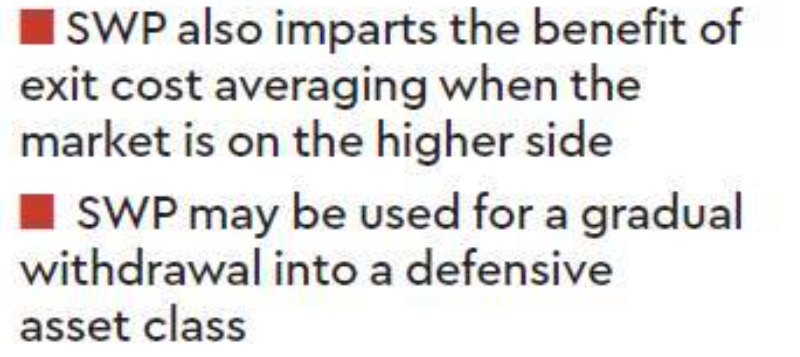What is SWP in Mutual Fund
5paisa Research Team
Last Updated: 24 Apr, 2024 10:08 AM IST

Content
- Introduction
- SWP in Mutual Funds
- Define your goals with a systematic withdrawal plan
- How does SWP work?
- Wrapping Up
Introduction
A Systematic Withdrawal Plan, also known as SWP, is optimised with the help of software to suit your income goals. A SIP, on the other hand, is based on a fixed amount that is invested in a fund at regular intervals for a predefined period.
SWP is one of the most popular methods for systematic investments in mutual funds. It is designed to create wealth for investors by investing in equity-oriented MFs. The advantage of SWP over SIP is that investors can withdraw money from their investments without incurring any penalty or tax liability.
What is Systematic Withdrawal Plan with Example
More About Mutual Funds
- NPS vs ELSS
- XIRR vs CAGR: Understanding Investment Return Metrics
- SWP and Dividend Plan
- What is Solution Oriented Mutual Funds?
- Growth Vs Dividend Reinvestment Option
- Annual vs Trailing vs Rolling Returns
- How to Get Capital Gain Statement for Mutual Funds
- Mutual Funds Vs Real Estate
- Mutual Funds vs. Hedge Funds
- Target Maturity Funds
- How to Check Mutual Fund Status with Folio Number
- Oldest Mutual Funds In India
- History Of Mutual Funds In India
- How To Redeem ELSS Before 3 Years?
- Types of Index Funds
- Who Regulates Mutual Funds In India?
- Mutual Fund Vs. Share Market
- Absolute Return in Mutual Fund
- ELSS Lock in Period
- Treasury Bills Repurchase (TREPS)
- Target Date Fund
- Stock SIP vs Mutual Fund SIP
- ULIP vs ELSS
- Long Term Capital Gain Tax on Mutual Funds
- Smart Beta Funds
- Inverted Yield Curve
- Sinking Fund
- Risk-Return Trade-Off
- Registrar and Transfer Agents (RTA)
- Mutual Funds Overlap
- Mutual Fund Redemption
- Mark to Market (MTM)
- Information Ratio
- Difference Between ETF and Index Fund
- Difference Between Mutual Fund and Index Fund
- Top 10 High Return Mutual Funds
- Passive Mutual Funds
- Passive Funds vs Active Funds
- Consolidated Account Statement
- Mutual Funds Minimum Investment
- What is Open Ended Mutual Fund?
- What is Closed End Mutual Fund?
- Real-Estate Mutual Funds
- How to Stop SIP?
- How to Invest in SIP
- What is a Blue Chip Fund?
- What is XIRR in Mutual Funds?
- What is a Hedge Fund?
- Tax Treatment of Long Term Capital Gains
- What is SIP?
- NAV in Mutual Funds
- Advantages of Mutual Funds
- Stocks vs Mutual Funds
- What is STP in Mutual Fund
- How Mutual Fund Works?
- What is Mutual Fund NAV?
- What are Mutual Funds?
- Mutual Fund Cut Off Time
- Mutual Fund the Best Investment Option for Conservative Investors
- Advantages and Disadvantages of Mutual Funds
- How to Choose Mutual Funds in India?
- How to Invest In Mutual Funds?
- How to Calculate NAV of Mutual Fund?
- What Is CAGR In Mutual Funds?
- What is AUM in Mutual Fund
- Total Expense Ratio
- What is XIRR in Mutual Funds?
- What is SWP in Mutual Fund
- How to Calculate Mutual Fund Return?
- Gold Mutual Funds
- Tax On Mutual Fund Investment
- The Top Benefits and Drawbacks of The Rupee Cost Averaging Approach
- How to Start a SIP Investment?
- What Is SIP & How does SIP Work?
- Best SIP Plans for Long Term: How and Where to Invest
- Best SIP Mutual Fund Plans
- ELSS Vs SIP
- Top Fund Managers in India
- What is NFO?
- Difference Between ETF and Mutual Fund
- ULIPs VS Mutual Funds
- Direct Vs. Regular Mutual Funds: What’s The Difference?
- ELSS vs Equity Mutual Fund
- NPS vs Mutual Fund
- Can NRIs Invest in Mutual Funds?
- Mutual Funds Categorisation In India
- Everything You Need to Know About Small-Cap Funds
- What is Public Provident Fund ?
- What is Large Cap Mutual Fund ?
- What is Index Fund ?
- What is IDCW in Mutual Fund ?
- What is Hybrid Fund?
- What is Gilt Fund ?
- What is ELSS Fund ?
- What is Debt Funds?
- What is an Asset Management Company - A Thorough Explanation
- What are Mid Cap Funds
- Liquid Funds - What are Liquid Funds?
- A Beginner's Guide to Investing in Fund of Funds Read More
Disclaimer: Investment in securities market are subject to market risks, read all the related documents carefully before investing. For detailed disclaimer please Click here.




